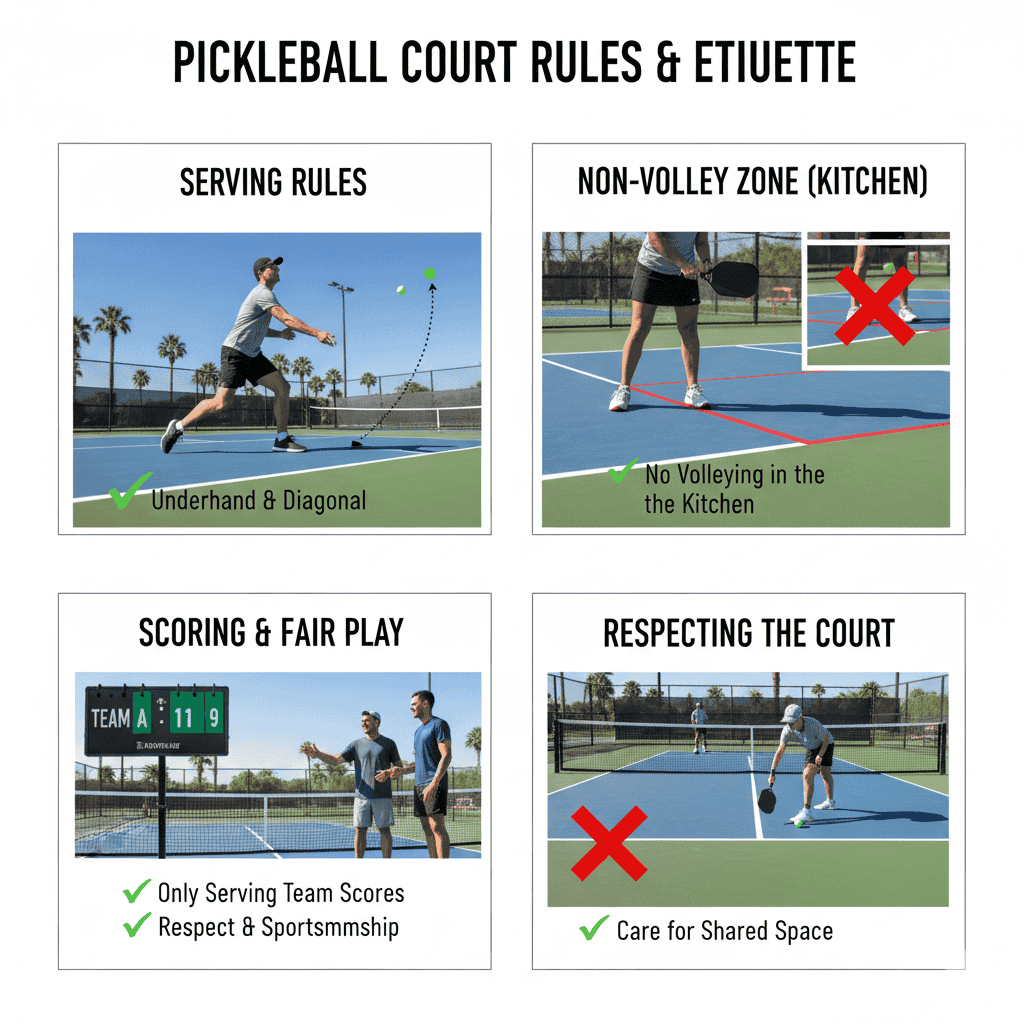Pickleball Court Rules and Etiquette
A Playing Field Built on Structure and Sportsmanship
On a Pickleball court, rules and etiquette function like the two wings of a bird or the two wheels of a cart—each essential, each supporting the other. Together, they create a fair, respectful, and enjoyable environment where every player can experience the true excitement and charm of Pickleball.
I. Court Rules: The Foundation of Fair Play
1. Serving Rules
Serving marks the start of every rally, and its rules are precise and intentional.
A server must stand with both feet behind the baseline and remain within the designated service zone. Stepping on or over the line is a fault. This ensures consistency in serving position and prevents players from gaining positional advantages.
All serves must be underhand, traveling diagonally across the court into the opponent’s service box. The ball must bounce once before being returned.
The underhand serve promotes fairness and strategy: the server must control spin, angle, and depth, while the receiver has time to anticipate the ball’s path and prepare their return.
2. Stroke and Contact Rules
Players may only strike the ball using their paddle; contact with any other part of the body is a fault.
This rule clarifies legal play and encourages players to refine their paddle control—timing, angle management, and shot power.
The ball may bounce once on a player’s side before it must be returned. A valid return can also be made before the bounce (a volley), as long as all other conditions are met.
This requires quick judgment of the ball’s height, direction, and pace, as well as precise placement to avoid hitting into the net or sending the ball out of bounds. Every shot must land within the opponent’s legal court area to keep the rally alive.
3. Scoring Rules
Pickleball uses a simple, strategic scoring system: only the serving team scores points.
Winning a rally while serving awards one point. This makes serving both an opportunity and a responsibility, while challenging receivers to earn breaks through smart defense.
Games are typically played to 11 points, with a requirement to win by at least 2 points.
At 10–10, the game continues until one side leads by 2. This structure creates tension, competitive depth, and the possibility of dramatic comebacks.
4. The Non-Volley Zone (Kitchen) Rule
The non-volley zone—commonly called the “kitchen”—is one of Pickleball’s signature features.
Players may not volley (hit the ball out of the air) while standing inside this zone. At the moment of impact, both feet must be outside the zone.
This prevents overly aggressive net domination and maintains balance between net play and baseline strategy.
When the ball lands in the kitchen, players must adapt—choosing soft dinks, controlled lifts, or tactical placements—gaining time to reset and build opportunities.
Outside the kitchen, players can move forward for volleys, smashes, and fast-paced exchanges.
II. Court Etiquette: The Spirit of Good Sportsmanship
1. Respecting Your Opponent
Respect is at the heart of Pickleball etiquette.
Players typically greet each other with a handshake or friendly acknowledgment before the match, setting a tone of camaraderie and mutual respect.
Throughout the game, players should remain composed—avoiding taunts, insults, or unsportsmanlike conduct.
Celebrations should be positive, not mocking. If an opponent makes an excellent shot, offering genuine praise reflects true sportsmanship and elevates the atmosphere for everyone.
2. Respecting Officials
Referees ensure fairness and order on the court.
Players should respect their decisions, even if they disagree. Any appeal should be made calmly and politely, with full acceptance of the final ruling.
Following directions related to serving order, timeouts, and match procedures helps keep the game smooth and organized.
3. Courteous Spectating
When spectators are present, both players and audience members contribute to the overall environment.
Players should stay focused despite external noise, while spectators should avoid shouting, loud distractions, or flash photography during rallies.
Cheers and applause are welcome at appropriate moments, but excessive noise disrupts play. Respectful spectating enhances enjoyment for all and supports the development of a positive culture around the sport.
4. Caring for the Court and Equipment
The court and equipment are essential shared resources.
Players should avoid damaging the surface, net, or surrounding areas—for example, by striking paddles on the ground or abusing the net.
Equipment should be handled gently and returned to its proper place after use.
Protecting the court reflects personal responsibility, reduces maintenance costs, and ensures a better playing experience for everyone.
In Conclusion
Pickleball court rules and etiquette are inseparable pillars of the sport.
Rules guarantee fairness, order, and competitive integrity; etiquette demonstrates character, respect, and the true spirit of athletic participation.
Whether you are a seasoned competitor or a new enthusiast, embracing both rules and etiquette allows you to fully appreciate the beauty of Pickleball—its excitement, its community, and the joy it brings to players everywhere.
Let us all play with integrity, respect, and enthusiasm, writing our own stories on this dynamic and welcoming court.

BHI Pickleball-Custom pickleball paddle






